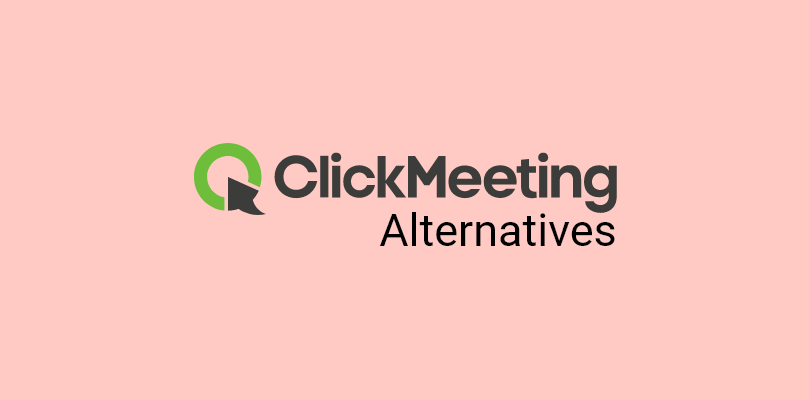There are dozens of webinar platforms. And too many sponsored blog posts about the best ones.
You need information, not a sales pitch.
I’ve done the hard work for you, comparing the features of the best webinar platforms.
No fluff, no hype. Just the information you need to make a smart decision. Save yourself some time and check it out.
| Webinar Software Platforms | Best for | Pricing |
| WebinarNinja | Best Webinar Software to Improve Marketing, Grow Sales, and Teach Better | A FREE 14-day trial available. Paid starts at $0.30/attendee/month (includes CourseNinja worth $1200). |
| Demio | Conducting Virtual Events for Marketers | Starts at $42/month. Single Host. 50 attendees. |
| BigMarker | Hosting Custom Branded Webinars | Custom pricing |
| eWebinar | Automated Webinars | Starts at $99/month |
| Crowdcast | Live Video Streaming | Starts at $49/month |
| Zoom | Video Conferencing | Free plan available (Limited to 40 mins/meeting). Paid plan starts from $159/year/user |
| Livestorm | Live Q&A Sessions | Forever free plan. Custom pricing |
| ClickMeeting | Organizing Periodic Events | Starts at $26/month |
| GetResponse | Webinar Building | Starts at $15.6/month |
| GoToWebinar | Webcast Mode | Starts at $49/organizer /month |
| Webex | Collaboration & Customer Experience | Starts at $11.46/license/month |
| WebinarJam | Live Chat | Custom pricing |
| WebinarGeek | Hybrid Webinars | Starts at $42.42/month |
| LiveWebinar | Webinar Recording | Free plan available. Starts at US$ 17.99 |
List of Top Webinar Platforms
Let’s get into the details of each platform. I have researched to narrow down your options, so you can easily decide which is best for you. Take the time to review each tool and consider its pros and cons to make an informed decision based on your business needs.
1. WebinarNinja
Best Webinar Software to Improve Marketing, Grow Sales, and Teach Better
If you’re looking for the best webinar software that will take your training sessions to the next level, I highly recommend giving WebinarNinja a try. You won’t be disappointed!
And here’s why!
Our training department had an incredible experience with WebinarNinja, and this has been our go-to platform for delivering live online courses. It completely transformed how we conducted our training sessions, making them more engaging and interactive.
Right from the start, we were impressed by how user-friendly WebinarNinja was. It was easy to set up and customize the webinars, which helped us create a seamless experience for our participants.
But the real magic happened during the live sessions. The streaming quality was top-notch, and our trainees could follow the sessions without any disruptions.
With features like chat rooms and polls, we created an interactive environment where everyone felt comfortable sharing their thoughts and asking questions.
| For instance, the MerryMaker Sisters, Emma and Carla, used WebinarNinja to establish a supportive and judgment-free community for their health and wellness programs. As they transitioned to online Yoga and Pilates programs in 2019, they sought a reliable marketing channel and found WebinarNinja to be the ideal solution.
Webinars became a pivotal part of their paid programs, which included interviews with health experts. The user-friendly interface of WebinarNinja made it their preferred choice among various webinar software options. This platform also helped them reach their ultimate goal of spreading joy and inspiring self-acceptance within their MerryBody Online Studio, which has garnered over 540 members. Read more customer stories here. |
What You Will Like:
- Simple interface, drag-and-drop functionality
- Competitive pricing, especially for automated webinars
- Combine live and pre-recorded elements to reach larger audiences
- Customized registration, thank you pages, and email follow-ups
- Best webinar experience on single screen
What You May Not Like:
- No native app for mobile devices
- There should be an option to switch to the dark mode.
Pricing
A FREE 14-day trial available. Paid starts at $0.30/attendee/month (includes CourseNinja worth $1200).
2. Demio
Best for Conducting Virtual Events for Marketers
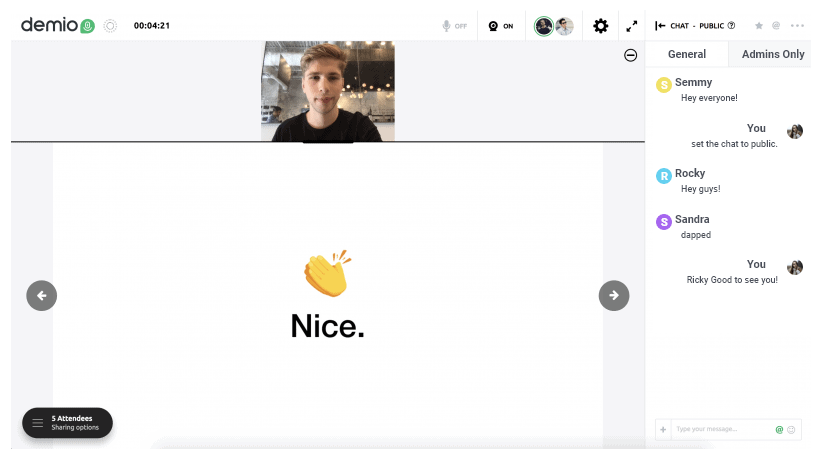
Demio is a comprehensive webinar platform explicitly designed for marketers who want to host virtual events.
It offers an intuitive, user-friendly interface that makes it easy to create and manage online events, and it boasts powerful features like customizable landing pages, interactive polls and surveys, and automatic webinar recordings that make it a top choice for businesses of all sizes.
With Demio, marketers can easily promote virtual events on social media, email, and other channels and host live or pre-recorded webinars that accommodate up to 500 attendees.
As one of the best webinar tools, it provides detailed analytics that enables marketers to track the success of their events, and it integrates with popular marketing automation and CRM systems like HubSpot, Salesforce, and Marketo.
What You Will Like:
- Easy scheduling and registration process
- Integrated chat, polls, and other engagement tools
- Automated recording and sharing options
What You May Not Like:
- Limited mobile access
- No advanced marketing features
- Issues with video upload from YouTube
Pricing
Starts at $42/month. Single Host. 50 attendees.
3. BigMarker
Best for Hosting Custom Branded Webinars
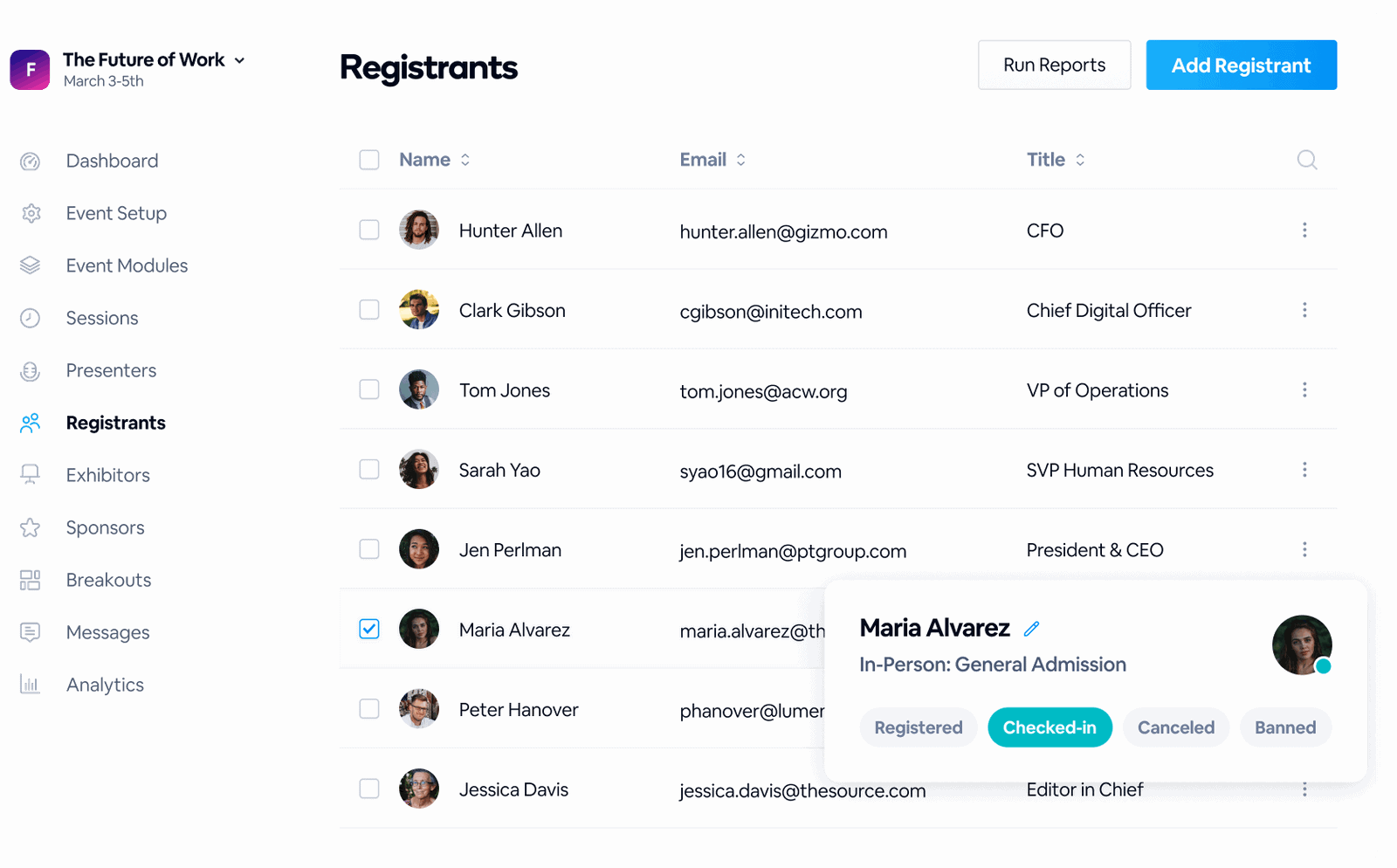
76% of marketers say that custom-branded webinars help them reach more leads, and 75% say it extends brand reach.
So, if you want a webinar platform that allows you to host custom-branded webinars, BigMarker is the solution.
With BigMarker, we were able to create interactive webinars that showcased our brand.
The platform offers customizable templates and themes, which allowed us to incorporate our organization’s logo, colors, and overall brand identity flawlessly. This creates a consistent and professional look for our virtual events.
But that’s not all!
From customizing the registration page and email invitations to branding the webinar room and materials, BigMarker allows you to showcase your brand throughout the entire webinar experience.
What You Will Like:
- Robust analytics and data tracking
- Integrated marketing tools such as landing pages, email automation, and analytics
- Customizable branding and templates
What You May Not Like:
- Steep learning curve for beginners
- Limited customizations for registration forms
- Occasional technical glitches
Pricing
Custom pricing
4. eWebinar
Best for Automated Webinars
Exhausted by the repetitive cycle of live webinars?
Juggling schedules, battling time zones, and enduring presentation fatigue can truly hinder your productivity and impact. But what if there was a better way?
Introducing eWebinar, one of the best webinar platforms that allows you to run hundreds of engaging webinars without being there. With this tool, these problems have become a thing of the past.
With this tool, you can turn your pre-recorded videos into automated webinars that feel as live and interactive as a traditional live webinar.
eWebinars offers a powerful solution that lets you automate your webinar presentations and achieve even better results than live webinars.
Experience 2X higher attendance rates, 90% watch times, and 3X higher conversion rates. The best part is that you can do all this without adding a single member to your team.
What You Will Like:
- Automated scheduling and recording
- Interactive features such as polls and Q&A
- On-demand and evergreen webinars
What You May Not Like:
- Expensive compared to other tools
- Limited live webinar options
Pricing
Starts at $99/month. Up to 1 active webinar. 3000 registrants/month
5. Crowdcast
Best for Live Video Streaming
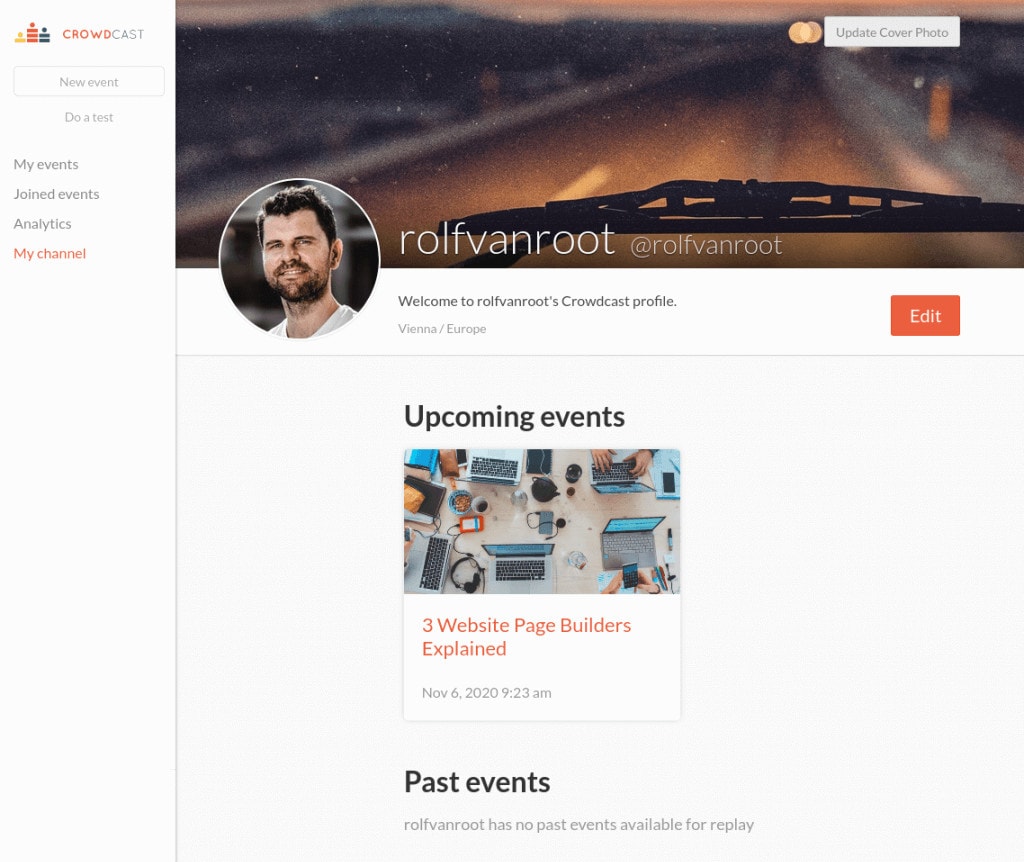
This webinar tool lets you stream live videos to your audience, interact with them in real-time, and grow your community.
Unlike traditional webinar software, Crowdcast is for creators who want to share their expertise, teach online, or host virtual events.
With Crowdcast, you can use built-in live production tools to create engaging moments, and broadcast to multiple platforms simultaneously. You can also host free or paid events, integrate with your favorite apps, and measure your success with analytics.
I haven’t tried Crowdcast myself, but I have seen my peers using it, and they have given some great feedback. They say it’s easy to use, has a clean design, and offers many features to connect with their audience.
So I thought of suggesting this tool, as it might be a great fit for your needs.
What You Will Like:
- Interactive features such as polls, quizzes, and Q&A
- Integrated scheduling and email invitations
- Audience engagement and segmentation options
What You May Not Like:
- Does not have evergreen webinar features
- Not suitable for small businesses
Pricing
Starts at $49/month. 100+attendees. 10 hours/month
Also Read: Crowdcast Alternatives to Grow Your Online Community
6. Zoom
Best for Video Conferencing
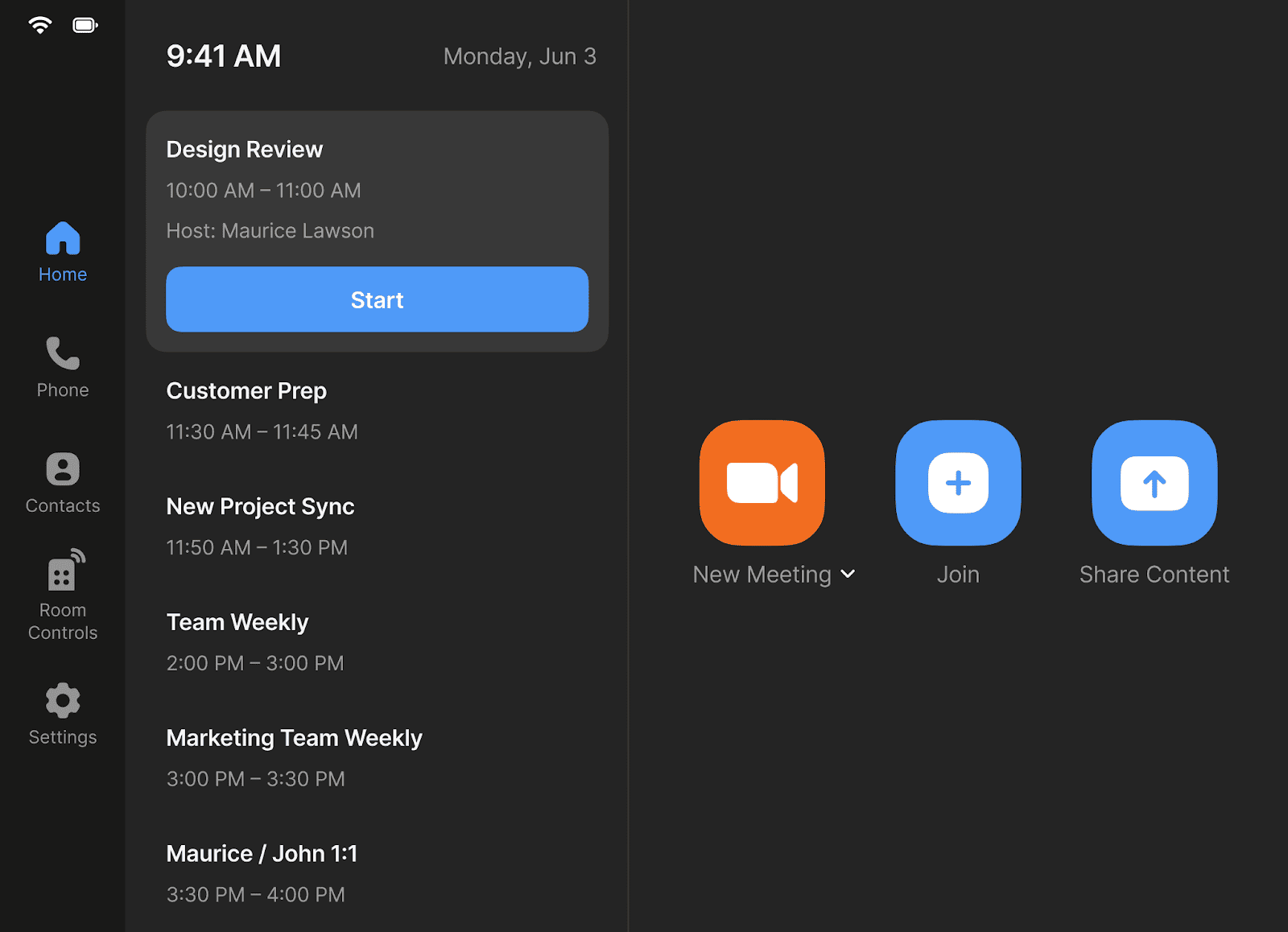
Zoom is a well-known solution and the ultimate tool for online communication. Whether you need to collaborate with your colleagues, train your learners, or celebrate with your friends, Zoom has you covered.
Zoom provides crystal-clear video and audio quality and a range of features to enhance your interaction.
You can share your screen, use the chat, draw on the whiteboard, create breakout rooms, and more. Zoom works seamlessly with popular apps like Google Calendar, Slack, and Salesforce, so you can easily schedule and join meetings.
No matter what kind of meeting you need to host, Zoom can handle it. From large webinars to small team meetings, one-on-one chats, and group parties, Zoom can connect you with anyone, anywhere.
What You Will Like:
- Large capacity for attendees and various types of webinars
- Easy-to-use interface
- Cost-effective for small businesses
What You May Not Like:
- Restrictive time limits for the free plan
- Additional costs associated with obtaining live support
- Security and privacy concerns
Pricing
Free plan available (Limited to 40 mins/meeting). Paid plan starts from $159/year/user. Team chat. 30 hours/meeting.
Also Read: Best Zoom Webinar Alternatives and Competitors
7. Livestorm
Best for Live Q&A Sessions
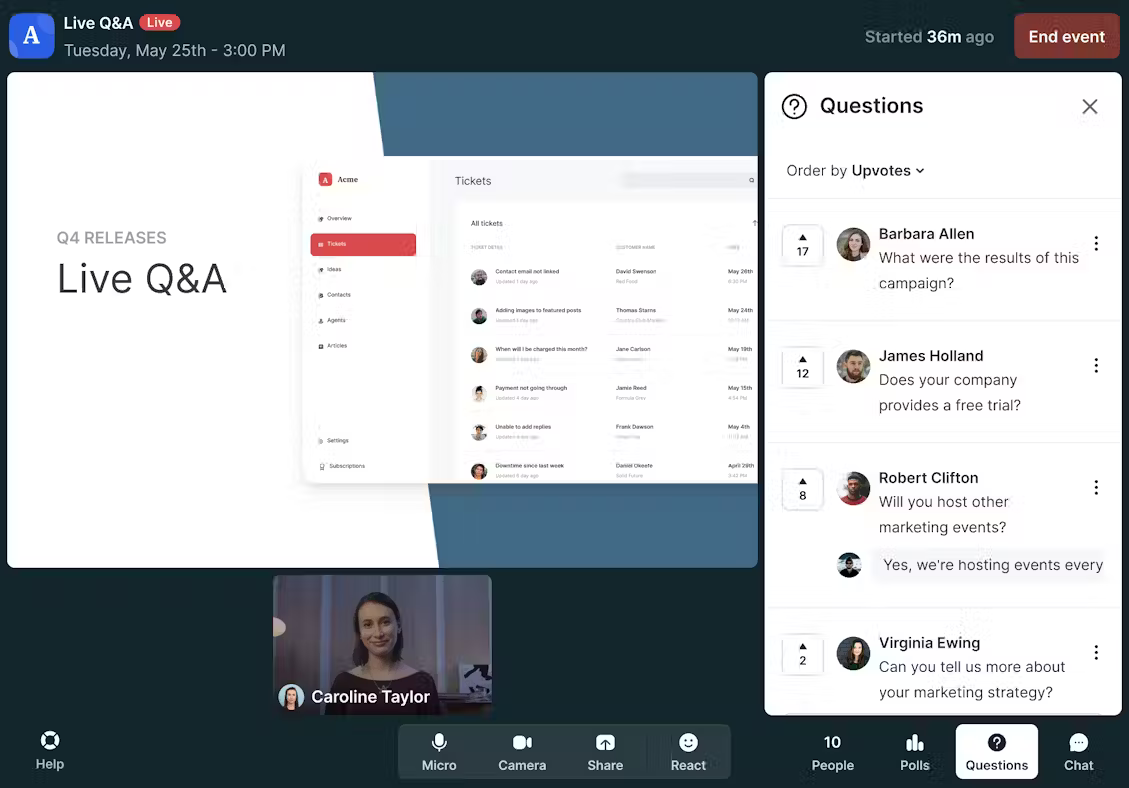
Livestorm is the go-to solution for hosting online conferences and events.
What sets it apart?
The fact that you can conduct Q&A sessions is something I really appreciate. This webinar platform facilitates interaction between hosts and the audience, adding dynamism and engagement to webinars. Participants ask questions, and hosts provide real-time responses. This feature fosters a more interactive and immersive webinar experience.
Livestorm’s features are a game-changer: from customizable registration pages and real-time polls to question upvotes and comprehensive analytics, it covers all bases.
The one-click invite and recurring event setup simplify promotion, while the high engagement during Q&A sessions is unmatched.
Whether you want to host conferences or improve internal communication, Livestorm emerges as the ultimate choice. Trusted by over 5,000 organizations, it has been considered one of the best webinar hosting platforms.
What You Will Like:
- Multiple engagement tools such as chat, polls, and Q&A
- Customizable registration pages
- Integration with other marketing tools
What You May Not Like:
- Expensive compared to other tools
- Limited advanced features for paid plans
- No on-demand webinars
Pricing
Forever free plan. Custom pricing
8. ClickMeeting
Best for Organizing Periodic Events
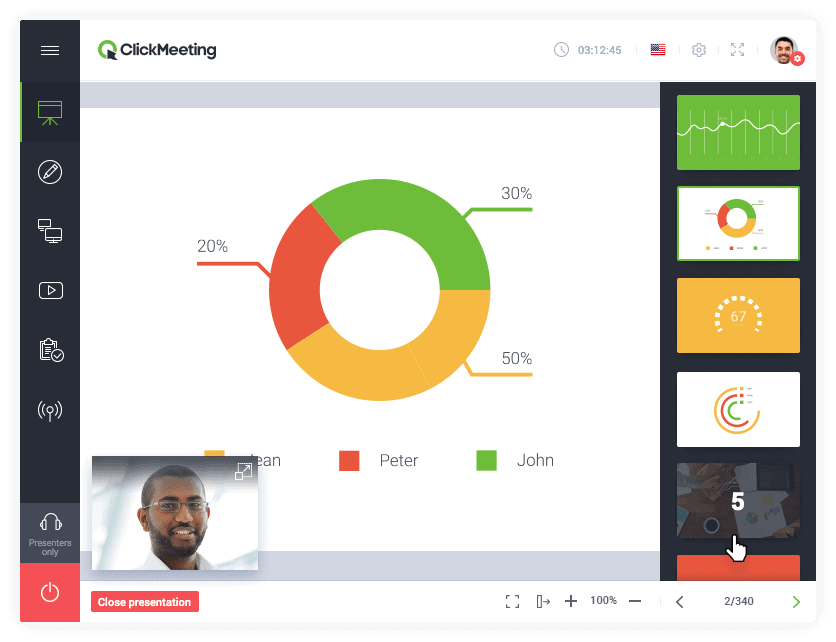
ClickMeeting is among the top webinar platforms that enable users to create and host online events of any size and frequency. ClickMeeting is a great tool to organize periodic events and talk to a large audience for a reduced cost.
Whether you want to run weekly meetings, monthly courses, or yearly conferences, ClickMeeting can help you schedule, automate, and manage your events with ease. You can customize your events with polls, surveys, chat, and paid options to engage and monetize your audience.
The best part is you can integrate ClickMeeting with various tools and platforms, such as Google Calendar, Facebook, YouTube, and PayPal, to streamline your workflow and reach more people.
ClickMeeting is one of the easiest-to-use webinar interfaces on the market, with quality proven by the results achieved by experts. With ClickMeeting, you can achieve your goals with scalable meetings, webinars, and conferences.
What You Will Like:
- Interactive features such as surveys and moderated chat
- Automated recording and sharing options
- Smart webinar scheduling
What You May Not Like:
- Does not provide automatic transcription of meetings or webinars
- Audio issues with users experiencing challenges related to sound quality
- Concerns were raised about the new version possibly focusing more on a younger audience
Pricing
Starts at $26/month. 1 host. 3 multi users.
9. GetResponse
Best for Webinar Building
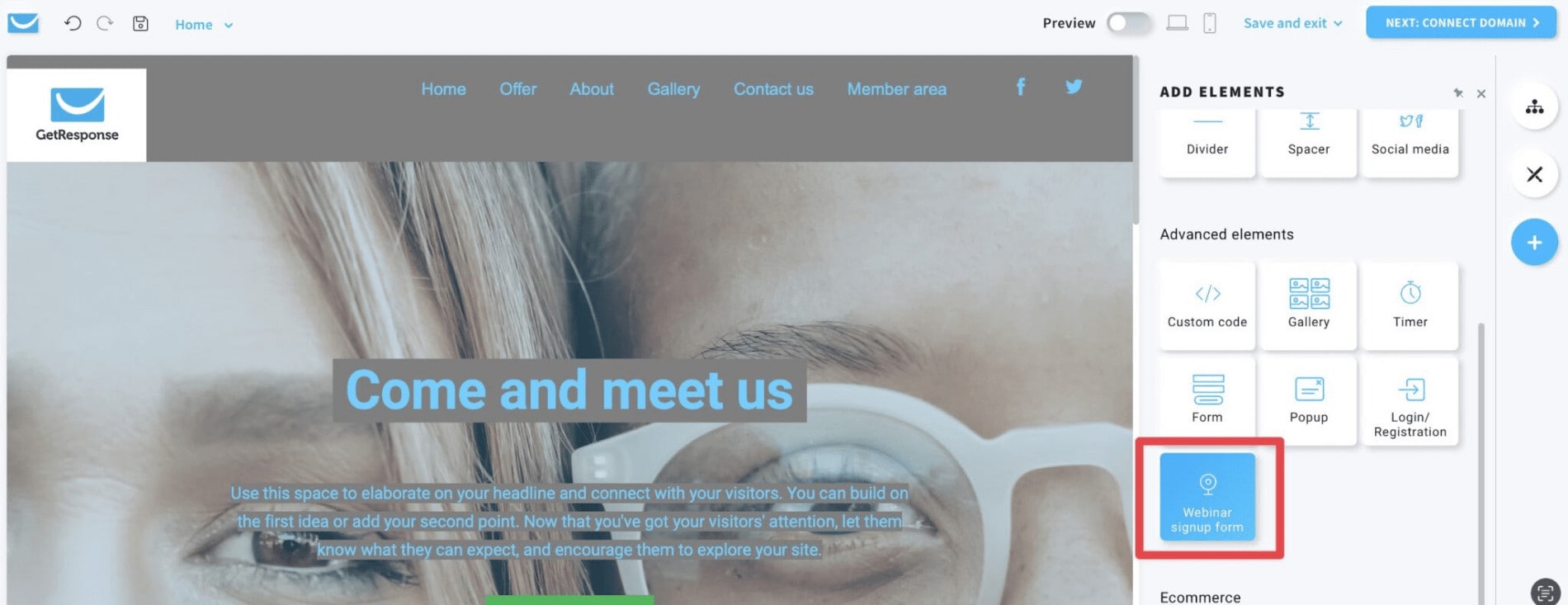
Unleash the power of webinars with this no-download, user-friendly webinar builder. Host unlimited webinars for up to 1,000 live attendees.
Elevate your online experiences with easy access, interactive tools, and built-in email marketing for higher conversions. Setting up a webinar is a breeze – flexible scheduling, customizable URLs, and hassle-free lead collection.
Maximize audience engagement with interactive features, file sharing, and live streaming on Facebook and YouTube. Evergreen webinars put lead generation on autopilot, and the mobile app lets you host webinars on the go.
Whether you want to manage remote teams, onboard employees, or showcase new products, GetResponse has covered you.
And if you’re a mid to large-sized company looking for advanced marketing tools, check out GetResponse MAX for dedicated support, SMS marketing automation, and more.
What You Will Like:
- Landing pages are included in all paid plans
- Multistep trip customization based on participant actions
- Offers a wide range of tools beyond email marketing, including automation, list growth, and live chats
What You May Not Like:
- Complex setup for webinars
- Has a limit of three speakers for webinars
- Some users have reported delays in account activation
Pricing
Starts at $15.6/month. AI email generator. Autoresponders.
10. GoToWebinar
Best for Webcast Mode
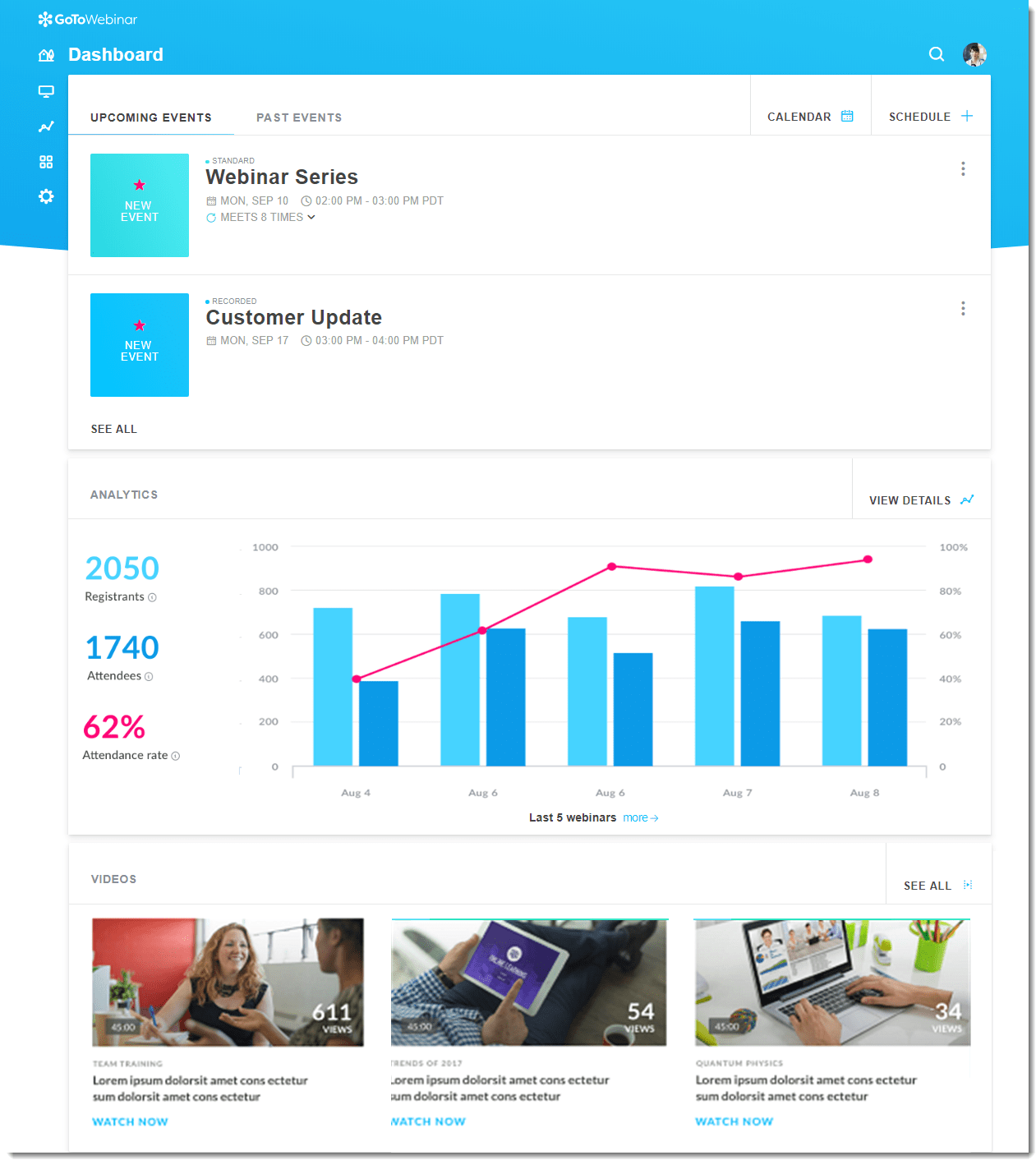
Our organization has harnessed the power of GoToWebinar’s Webcast Mode, and the results have been phenomenal. This tool takes the hassle out of virtual event planning, allowing us to host large-scale video webcasts with up to 3,000 attendees.
The transition to enterprise-quality webcasts has been seamless, even for those without extensive training.
What sets GoToWebinar apart is its unique Webcast Mode, which accommodates 3,000 live-stream participants. This surpasses the capabilities of standard webinars, making it a go-to choice for our large-scale events.
The ease with which attendees join from desktops, browsers, or mobile apps has simplified our audience engagement strategy.
The benefits are manifold – from the global reach that live webcasts provide to the cost savings on travel expenses.
The platform’s user-friendly features, like high-quality audio and video, slideshow presentations, document downloads, live chat, and polling tools, have allowed us to communicate more productively.
What You Will Like:
- Stable and reliable webinar platform
- Whiteboards and breakout rooms
- Accommodate large audiences with ease
What You May Not Like:
- Occasional glitches during the registration process
- Limited attendee engagement tools
- Learning curve for advanced features
Pricing
Starts at $49/organizer /month. 250 participants. Full service registration.
Also Read: Best GoToWebinar Alternatives to Create Impactful Events
11. Webex
Best for Collaboration & Customer Experience
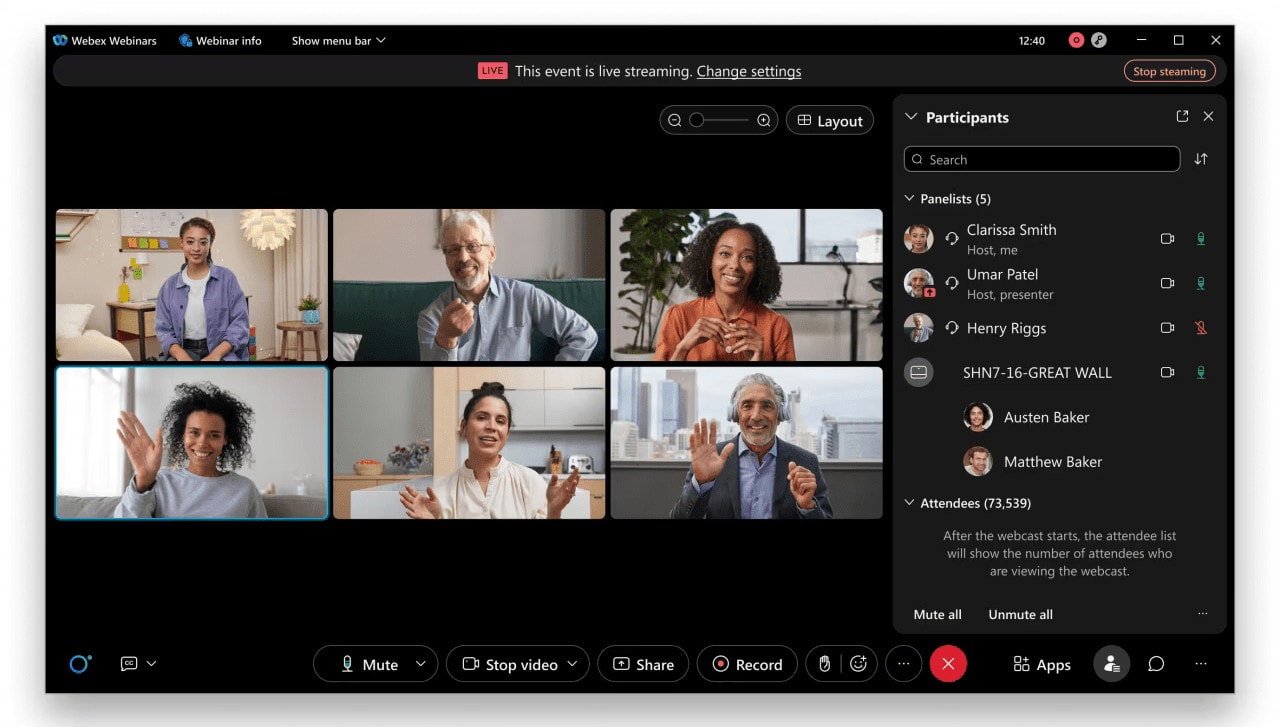
We know how important collaboration is, especially in today’s dynamic work environment. That’s why I recommend you try Webex, a leading video conference and collaboration platform that redefines how remote teams work together.
With Webex, the possibilities are limitless. Experience face-to-face meetings with crystal-clear HD video and advanced audio quality. Call, message, and share files seamlessly with anyone, anywhere, anytime.
But that’s just the tip of the iceberg. Webex leverages AI to bring cutting-edge features like noise cancellation, transcription, and translation.
Need to host webinars, events, or hybrid meetings with a massive audience? Webex has you covered, as it supports up to 100,000 attendees. Engage your participants with whiteboards, polls, and video messages, and create a truly interactive experience.
Also, if you’ve been looking for free webinar tools, try out Webex!
What You Will Like:
- Users can easily share their desktops, documents, or any application on their computer
- Simple and easy to create whiteboards
- Provides an easy-to-share option for all types of content during the meeting
What You May Not Like:
- Comment control and chat control are weak
- The website version is weaker as compared to the app version
- Learning curve for new users
Pricing
Free plan available. Limited to 40 mins/meeting. Paid plans start at $11.46/license/month. Meeting length up to 24hrs. Up to 150 attendees.
12. WebinarJam
Best for Live Chat
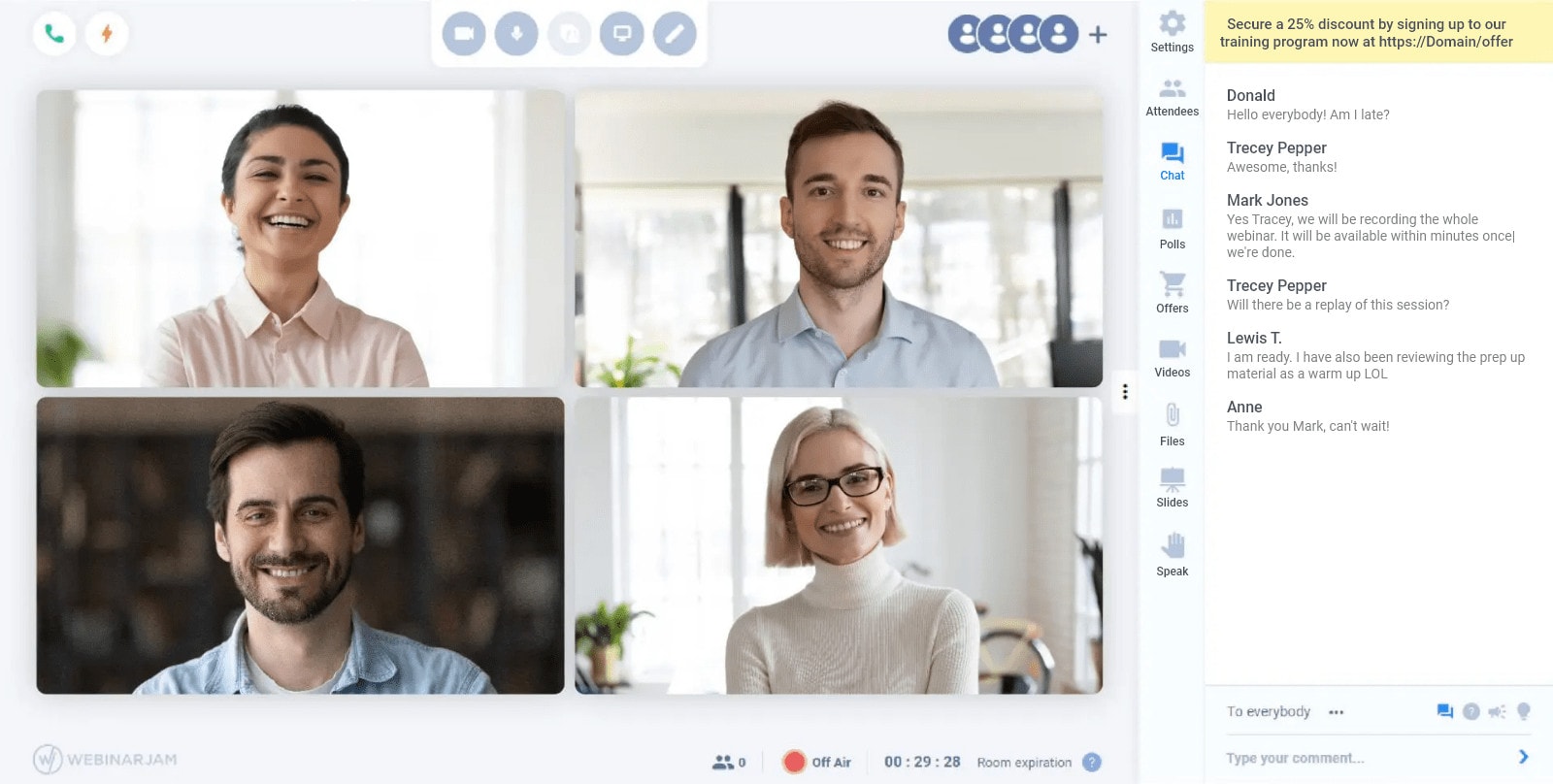
WebinarJam stands out as the best choice for live chat during webinars. The live chat feature empowers you with flexible options like Q&A sessions, private comments, highlighted announcements, and more. This ensures your attendees stay fully hooked throughout the event.
With its cloud-based broadcasting technology, this robust webinar platform allows you to connect with up to 5,000 attendees. This helps your message reach thousands without breaking the bank.
Engage your audience with high-quality video and audio broadcast in HD glory, free from pixelation or choppy frame rates.
The”Attendee Spotlight” feature invites audience members to join you on the virtual stage. This feature empowers your audience to share their insights.
The Panic Button feature ensures a smooth experience even in the face of technical glitches which allows you to install-boot a new room and auto-redirect attendees. WebinarJam also excels in audience interaction with polls, surveys, and real-time engagement analytics.
What You Will Like:
- Helps create professional-level webinars
- It takes care of a lot of issues for marketing your online events, with notification and tracking
- Allows you to invite an attendee as a guest presenter during the webinar
What You May Not Like:
- You need to pay an additional fee for hosting evergreen webinars
- Basic landing pages
- Not all plans offer control panels
Pricing
Custom pricing
Also Read: Best WebinarJam Alternatives to Create Interactive Webinars
13. WebinarGeek
Best for Hybrid Webinars
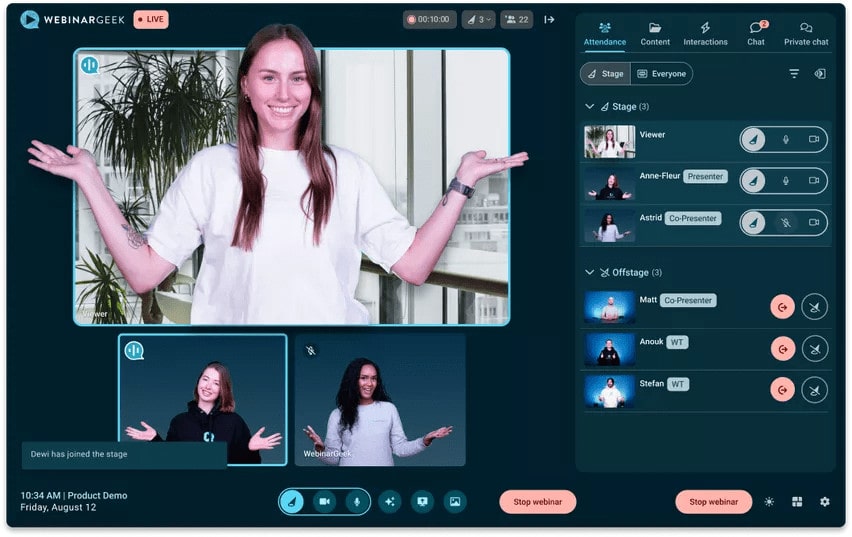
Are you tired of the stress of presenting webinars live? Try WebinarGeek’s hybrid webinar that combines a live webinar with pre-recorded videos or presentations.
This innovative tool allows you to give your undivided attention to your audience. WebinarGeek is ideal for product demos, presentations, or any scenarios, especially when you want to focus on viewer engagement.
Organize invitations and follow-ups independently with this user-friendly, software-free solution. It’s a versatile webinar platform with features like video injections, automated webinars, and detailed statistics.
Perfect your presentations by practicing and recording as many times as needed. Start a 14-day free trial, explore premium features, and elevate your webinar game with WebinarGeek.
What You Will Like:
- Supports live, automated, and hybrid webinars
- Offers SEO settings for the registration page
- Provides sales tools, including CTAs and a sales page that lets you push leads
What You May Not Like:
- Takes quite a while to set up
- No provisions for attentiveness tracking
- Doesn’t let you send customized emails to viewers or non-viewers
Pricing
Starts at $42.42/month. 1 Presenter. 2-hour Session Limit
Also Read: WebinarGeek Alternatives to Grow Your Audience [Detailed Comparison]
14. LiveWebinar
Best for Webinar Recording
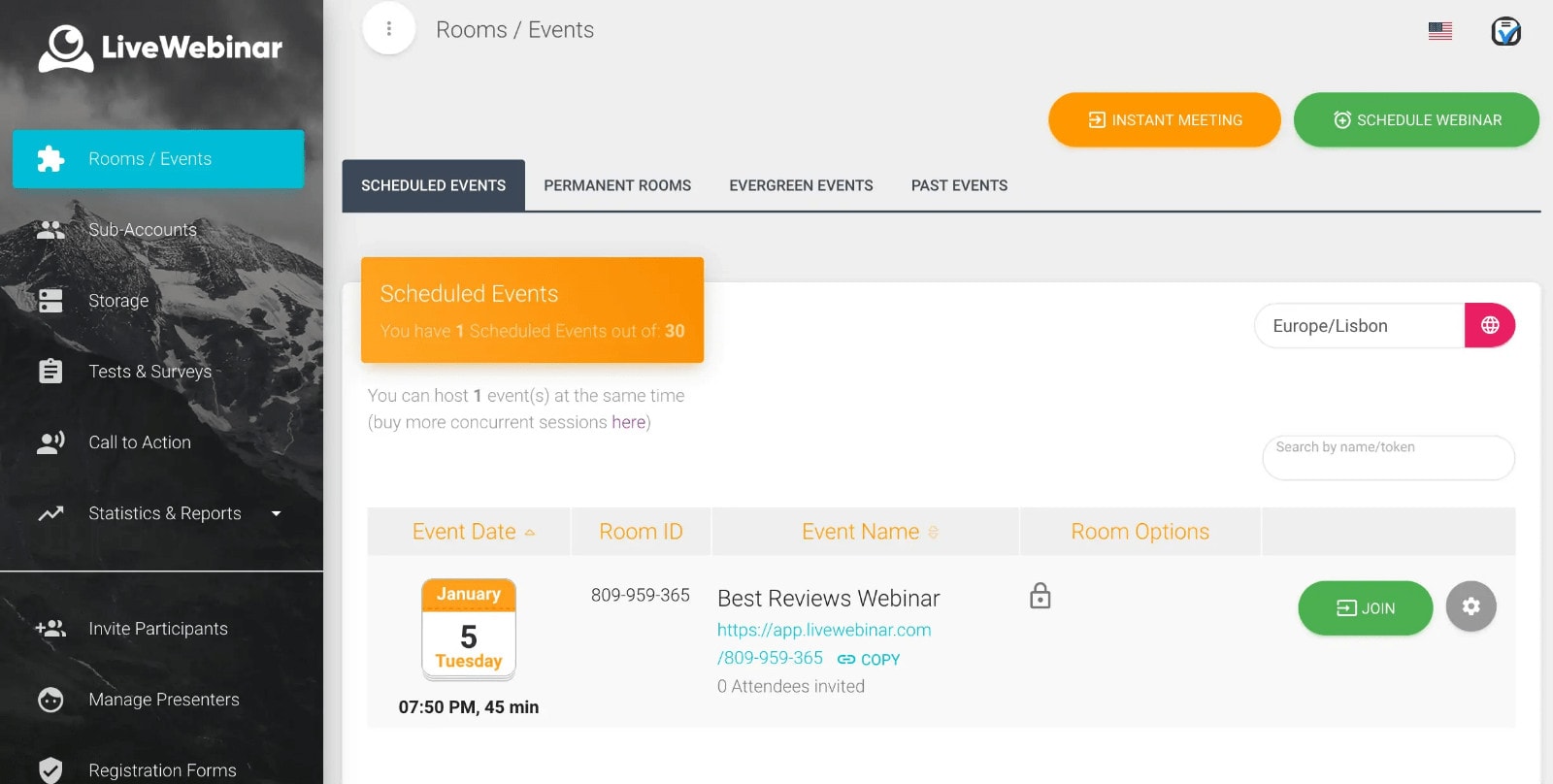
Don’t let your webinar’s impact fade. Capture and preserve its value to unlock long-term benefits. This ensures your valuable knowledge remains accessible for future reference, not just for the initial live audience.
LiveWebinar’s cutting-edge Webinar Recorder empowers you to capture, store, and access live webinars at your convenience.
With this tool, you can preserve real-time presentations, ensuring that discussions are never lost. The easy-to-use recording feature transforms live events into enduring content, whether for reviewing, sharing, or editing. Customize your recording layout, edit content, and share it effortlessly.
The tool’s flexibility allows you to generate leads through evergreen webinars, reaching your audience long after the live event concludes. Revisit, repurpose, and maximize the impact of your webinars with LiveWebinar.
What You Will Like:
- Doesn’t require participants to download software
- Allows for a diverse range of attendees from all over the world
- Easy to set up and start using
What You May Not Like:
- Lacks advanced collaboration features like multiple screen sharing
- The whiteboard feature lacks advanced drawing tools
- It has breakout rooms, but it lacks advanced management features
Pricing
Free plan available (Limited to 5 attendees. 1 Live session). Paid plans start at $ 17.99. Host up to 100 attendees or more with add-ons.
Also Read: Top 10 LiveWebinar Alternatives
Which is the Best Webinar Platform?
To choose the best webinar platform from these many available options, you need to consider various factors like its ease of use and core features like screen sharing, chat options, and recording capabilities. You also need to ensure it supports the number of attendees you expect.
Based on these factors, my top three choices are:
Option A: WebinarNinja
Ideal for delivering live online courses, WebinarNinja is marked by a simple interface, competitive pricing, and the ability to combine live and pre-recorded elements. The setup is headache-free and you can do personalized branding for an engaging and interactive learning environment.
Option B: Demio
Demio features an intuitive interface, easy scheduling, and robust engagement tools. It integrates seamlessly with popular systems, offering marketers efficient promotion, live or pre-recorded webinars for up to 500 attendees, and detailed analytics to track event success.
Option C: BigMarker
Tailored for custom-branded webinars, BigMarker allows effortless branding throughout the webinar experience. It offers interactive features, integrated marketing tools, and robust analytics. With unlimited webinars and attendees, BigMarker enables impactful virtual events.
WebinarNinja stole the show with its user-friendly interface and budget-friendly pricing. Its seamless blend of live and pre-recorded elements makes it a masterclass in online course delivery. While other platforms offer bells and whistles, WebinarNinja shines for its simplicity and effectiveness in meeting diverse webinar needs.
Hope this webinar platform comparison post helps you find the best solution for your needs.
Evaluation Criteria
The evaluation of products or tools chosen for this article follows an unbiased, systematic approach that ensures a fair, insightful, and well-rounded review. This method employs six key factors:
- User Reviews / Ratings: Direct user experiences, including ratings and feedback from reputable sites, provide a ground-level perspective. This feedback is critical in understanding overall satisfaction and potential problems.
- Essential Features & Functionality: The value of a product is ascertained by its core features and overall functionality. Through an in-depth exploration of these aspects, the practical usefulness and effectiveness of the tools are carefully evaluated.
- Ease of Use: The user-friendliness of a product or service is assessed, focusing on the design, interface, and navigation. This ensures a positive experience for users of all levels of expertise.
- Customer Support: The quality of customer support is examined, taking into account its efficiency and how well it supports users in different phases – setting up, addressing concerns, and resolving operational issues.
- Value for Money: Value for money is evaluated by comparing the quality, performance, and features. The goal is to help the reader understand whether they would be getting their money’s worth.
- Personal Experience / Experts’ Opinions: This part of the evaluation criteria draws insightful observations from the personal experience of the writer and the opinions of industry experts.
Want to host a webinar for free?
Use WebinarNinja to teach, improve marketing, and grow your sales.



![How to Host Paid Webinars [A Practical Guide + 6 Best Tools]](https://webinarninja.com/blog/wp-content/uploads/2020/05/Feature_WN_How-to-Host-Paid-Webinars-A-Practical-Guide-5-Best-Tools.png)




